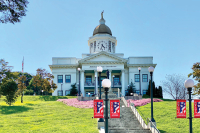Smokies relies on outside support to maintain what makes it special
When Steve Woody and Barney Coulter got a mysterious call from Smokies Superintendent Randall Pope in the early 1990s asking to see them in his office, they dutifully, albeit curiously, complied.
Neither were used to taking orders — Coulter as the former chancellor of Western Carolina University nor Woody as the manager of an Asheville-based defense contractor. But they went along out of affinity and respect for the park, and as a good excuse to make the scenic sojourn from their homes in Western North Carolina to park headquarters on the other side of the Smokies.
When they arrived, they assembled around a table with others who had apparently received similar calls. Among them was Judge Gary Wade of Tennessee, who recently hiked to Mount Cammerer only to find the once-glorious Civilian Conservation Corps fire tower crowning the peak on the verge of collapse.
An upset Wade had come to Pope and demanded he fix it, only to learn the park was hamstrung due to a lack of funding. The upshot: the Smokies needed a Friends group.
Hundreds of Friends groups exist today — not just for parks but any special place, be it a historic lighthouse, library, museum or city park. But the concept of dispatching supporters to raise money for an entity supposedly funded by tax dollars was new at the time.
“You drive though and it looks good. What could it possibly need?” Coulter asked.
Related Items
But in fact, trails were eroding, historic cabins rotting, visitor brochures outdated, ranger programs lacking, campsites growing shabby, environmental threats mounting and the list goes on. With a bare bones budget, the park would diminish in quality over time unless something was done.
“It would not be the great place to visit that it is,” Coulter said. “We could not afford to let the park suffer.”
As they hashed out the idea, Coulter was filled with excitement, yet overwhelmed.
“It sounded like a monumental idea, larger than life. The needs were so great and we thought ‘How do we do this?’” Coulter said.
Pope wanted to lock in commitment on the spot and made a bold pitch to those in the room.
“He said ‘We need some money to get this thing started. Why don’t you each write a check for $1,000,’” Woody recalled. And so they did.
Since that day, Friends of the Smokies has raised $26.3 million for the national park. It is considered one of the most successful Friends organizations in the nation. Their strategy: raise friends, and funds will follow. But it took time to build the critical mass they enjoy today.
“We were pretty much lone rangers out there for a while,” Coulter said. “First we had to develop the story we wanted to tell — why the park is important to all of us, why it is important to the arts and the economy and to nature, why it is important to our collective history.”
In a few short years, the Friends caught on, growing to 4,500 members. Those who depend on the park for tourism, claim it as their heritage or simply relish wilderness all found a reason to support the organization.
“The Friends serve a tremendous purpose in underwriting the goals and aspirations of the park,” said Ken Wilson, a former board member of Friends of the Smokies.
As a newspaper publisher in Waynesville for 20 years, Wilson witnessed the national park’s huge but sometimes subtle footprint. Wilson believes the park defines the community’s collective consciousness.
“I think people who live here, move here and call this place home have a connection with nature in a way that those who live in other parts of the state do not,” said Wilson, who is also a nature photographer. “I think they are here because of that. They are here because that means something to them.”
The Smokies has a disadvantage compared to other major parks. It doesn’t charge an entrance fee, upholding a promise made by park founders when raising money and carving out land for its creation more than 75 years ago. Free entry is surely a Godsend for families or budget backpackers. But the Smokies has less money to work with as a result.
“This park has a bigger hill to climb than the other major national parks,” said Jim Hart, the executive director of Friends of the Smokies.
Perhaps one of the greatest challenges facing the Friends is what to fund every year. Brook trout restoration or elk reintroduction? A crumbling fire tower or new roof for Mingus Mill? School fieldtrips or guided hikes for the public?
Park rangers put their heads together once a year to come up with a wish list that’s presented to the Friends — both of imminent needs and long-range wants. Friends takes the list to heart, but sometimes inserts projects of their own if near and dear to a particular donor.
For example, Toyota donated $1 million over five years to spark students’ interest in science and environmental fields, using the Smokies as a backdrop.
“Parks provide a great place to teach children those building blocks of science,” said George Ivey, a grant writer with Friends of the Smokies. It wasn’t on the park’s list, but was gladly accepted.
And the Aslan Foundation donated $2 million for Trails Forever, an endowment that would permanently fund a third trail crew for the park.
“There was only one trail crew on each side of the park for 800 miles of trails,” Hart said. Crews couldn’t keep up, and the quality of the park’s trails were backsliding.
The National Park Service often gets mired in its own bureaucracy. It takes years for a funding request to lumber its way through the federal budget process. The park can’t react fast when hemlocks come under attack or a windstorm blows shingles off a cabin.
“They have a long and complicated budget process. But we can give money to the park with a quick turnaround,” said Woody, who serves as vice president of the board.
Woody’s role with the Friends is ironic in a way. His grandfather was the last person still living in the park on the North Carolina side, remaining in Cataloochee until 1942 when old age, the war and isolation finally drove him out.
While Woody’s grandfather never forgave the park for taking his farm and homeplace, Woody believes it was the best thing that could have happened to the region and sees the greater good served by his ancestors’ sacrifice.
“It’s an island of peace and serenity where people can go and get away from the frantic lifestyle we’ve developed,” Woody said of the Smokies.









